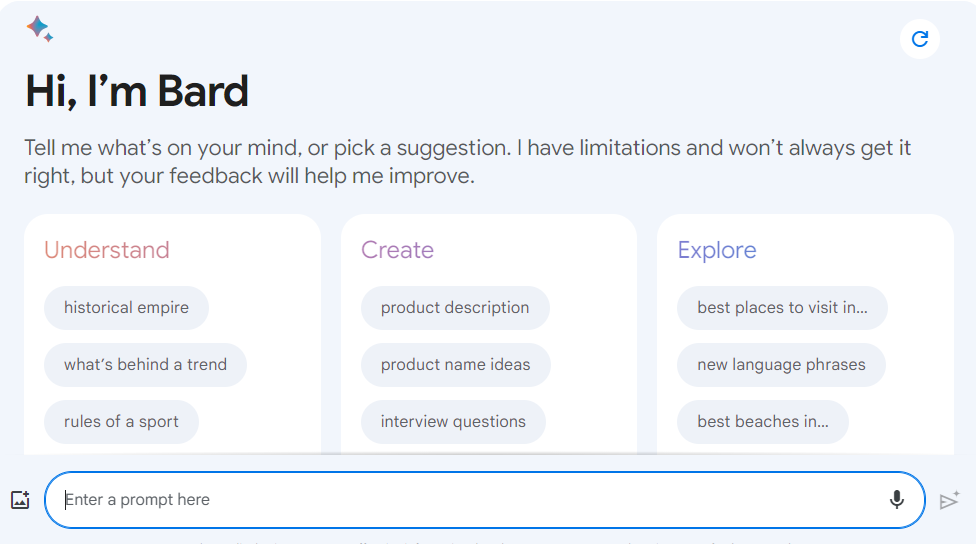
Any software that converses with humans, usually text-based, is known as a chatbot. But when combined with intelligent algorithms, these tools become AI chatbots. AI chatbots use natural language processing to analyze spoken or written prompts and generate responses. Typically, these bots use large databases to derive meaning.
Bard is a conversational Google AI chatbot. This LLM Large Language Model uses NLP and LaMDA to train on large text and code datasets. With this AI bot, users can generate lengthy text, analyze data, automate routine tasks, and research.
Bard is an experimental project, which means it is developing with time. Therefore, there is much to discover about its capabilities and functionalities. Want to know the progress up until now? Here is a complete guide to decode the potential of Google Bard.
In this article
Part I. Understanding Google Bard
Google has based Bard AI on LaMDA (Language Model for Dialogue Applications) and PaLM 2 (Pathways Language Model 2). The model was initially developed around research. Currently, it specializes in multi-turn dialogue by mimicking a natural conversation through deep learning.
Like other AI chatbots, Bard AI is also for human interaction. The user enters a written prompt, and the system scans it against the trained knowledge. After this, it derives meaningful insights using analysis and answers the queries.
Capabilities
- Collecting and analyzing data from user responses
- Using AI algorithms to generate answers to user queries
- Brainstorming creative ideas using its conversational chatbot
- Task automation using Google Apps and Services integration
- Exporting and running codes
- AI assistant to schedule tasks and manage time
Importance of Bard AI
Currently, Bard AI is being compared with ChatGPT across the Internet. But they are not as similar as it may occur. Google Bard has made research more natural, as it mimics human conversations to answer queries.
Moreover, Bard AI is integrated with Google Search. Users can verify Bard-generated information and answers on Google per the latest updates. Unlike other chatbots, it is also trained on up-to-date databases; the responses are usually new and updated.
However, Bard AI is still developing, and Google is working on code export, better visualization, and multilingualism. Thus, there will be much more to unravel with Bard.
Part II. Benefits and Applications of Google Bard
Benefits of Bard AI
Using Bard AI helps you optimize routine work. Here are some of its benefits across various industries.
Enhancing Customer Support
Bard AI uses natural language processing technology for text analysis. It is capable of analyzing sentiments and deriving meaningful insights from customer feedback. This way, businesses can better evaluate and satisfy their customers’ needs.
Streamlining Workflow
The latest Bard AI updates introduced its integration with Google Apps and Services. Online businesses can use this feature to automate routine tasks. Now, they can automate sending emails, generating reports, and updating data.
User Customization
Bard AI uses LaMDA (Language Model for Dialogue Applications) to converse with users. It specializes in multi-turn dialogues by using machine learning and data analytics algorithms. This way, it extracts keywords in the prompts and generates user-specific responses accordingly.
Applications of Bard
| Industries | Use Cases |
| E-Commerce |
|
| Education |
|
| Hospitality |
|
| Healthcare |
|
| Creative Industries |
|
Part III. Getting Started with Google Bard
Pre-Requisites to Setup Bard
The only pre-requisite for setting up a Bard account is a Google account.
Step-by-Step Guide to Getting Started on Bard
- Open Bard AI on your browser or download its application.
- Click Sign In, and enter your credentials.

- Read the Bard AI privacy policy and click I Agree on the pop-up menu.
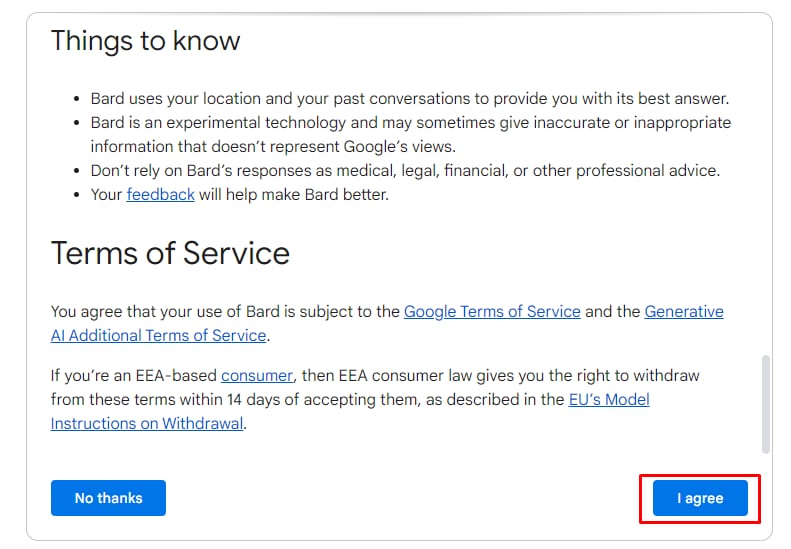
- Once done, you will see a page suggesting that Bard AI is an experiment. After reading it, press
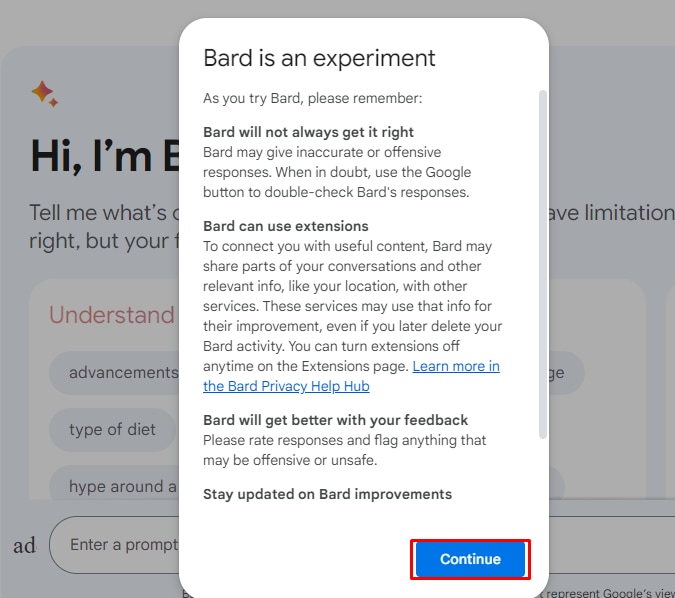
- Finally, your account is good to go. You can start a conversation with Bard by inserting a written prompt.
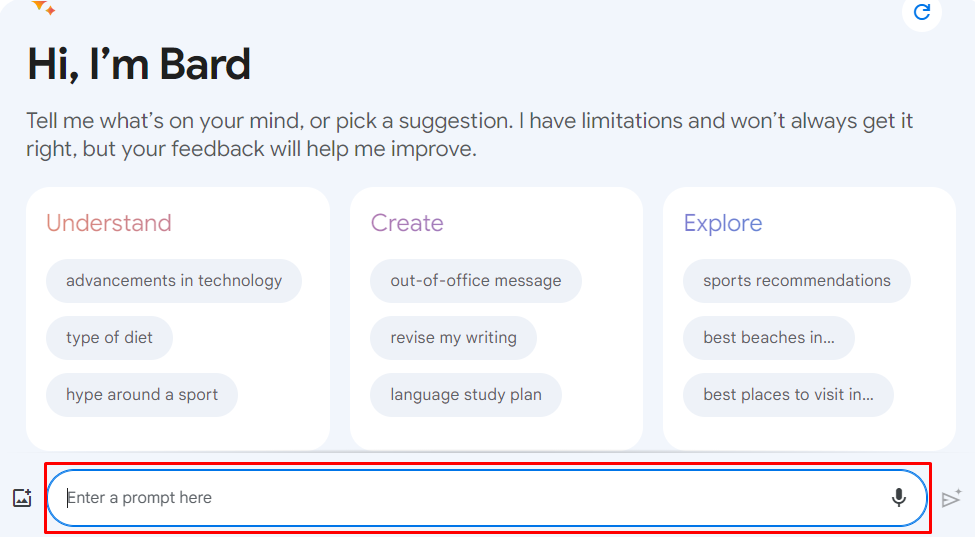
Best Practices for Optimizing Bard Performance
Bard is similar to other conversational AI models like ChatGPT. So, using it effectively requires certain practices. Let us discuss some:
- Clear Prompts: Provide concise inputs. It can be a statement or a question.
- Incorporate Prompt Details: Add constraints like target audience, writing styles, times, and more for accurate results.
- Experiment with the Outcome: Ask Bard to provide multiple responses or engage in debates. It will help you get detailed answers.
- Review the Response: Check the Bard output thoroughly. Bard is in the experimental stages, so accuracy is not its best characteristic. So, verifying the information and adjusting the output using the new G button is better.
Tips for Integrating Bard with Existing Platforms
Bard AI offers integration with Google Apps and Services. It helps you automate routine tasks and streamline workflow. Check out these practices before applying integration.
- Define the Integration Goals: Know why you are integrating Bard AI with external platforms. Identify the type of data you want to sync between the platforms.
- Select Appropriate Actions: Select automated actions that closely resemble your integration goals. For instance, if you want to receive an email notification every time there is a message in your Google Workspace, select Email Notification.
- Test Integrations: It is better to check whether the integration works fine. Use mockup data and test the sync between the two platforms.
- Monitor Performance: Always schedule days to check the integration. Keep the platforms updated and ensure there are no operational errors.
Part IV: Google Bard Alternatives
Want to explore something even better? Let us discuss some popular Google Bard alternatives in the market.
1. EdrawMax AI

EdrawMax AI chat is yet another conversational AI chatbot powered by GPT-4. It uses a dialogue-based prompt style to generate responses. Unlike traditional online chats, the bot will also ask you follow-up questions and provide feedback for better accuracy.
Next, it allows converting these responses into fully-fledged diagrams like mind maps, flowcharts, Gantt charts, etc. It goes a step further and uses smart algorithms to analyze these diagrams. With this, you can plan projects way ahead, improve their efficiency, allocate resources, and manage workload.
Features
- One-click Diagramming. You can generate a flowchart, a timeline, a mind map and more with a single click.
- AI Diagram Analysis. Ask AI to describe flowcharts, generate a project progress report from a Gantt chart, identify project risks, predict operation data trends, and more.
- OCR Drawing. Use AI to generate a drawing from a text or picture prompt.
- AI Copywriting. Ask AI to generate copy, modify or translate text.
2. Microsoft New Bing

Microsoft has also launched its New Bing AI Chat with updated features. The new version is powered by GPT-4 and has the ability to access the internet for references-backed responses, just like Bard.
But that’s not it. It has three conversational styles: creative, precise, and balanced, customizing the experience specific to the purpose. Unlike Bard, you can also create and search for visuals with its built-in image generator.
Features
- Reference links-backed responses
- Built-in image generator
- Three conversational styles
- Supports 20 exchanges per conversation
3. ChatSonic
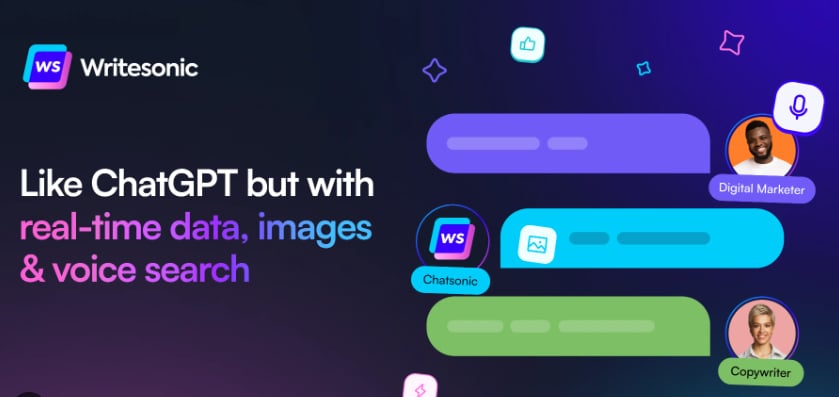
ChatSonic by Writesonic is an online chatbot for content production. What sets it apart from Google Bard? Simple, its accuracy. This bot provides footnotes and links to refer to the source of the response. So, you have an idea of where the data is taken from the internet. Not only this, it has a massive prompt library with pre-written keywords, helping non-technical users draft a thorough command.
Features
- A Large prompt library with SEO keywords and commands.
- Voice-to-text prompt converter
- Social media integration
- Available as mobile application
- Built-in image generator
Part V. Challenges and Limitations of Google Bard
AI Bots like Bard are evolving every day. However, they come with many ethical and operational limitations. Considering that Bard AI is still in the developmental stages, the following are some challenges it has to overcome in the future.
Ambiguity and Inaccuracies
Bard AI is trained on massive datasets, which may possess inaccuracies and biased information. Hence, there is no guarantee that Bard-generated responses will be accurate. Also, they are not backed by sources and do not provide links from where the data is derived.
Privacy Risks
Bard AI processes large datasets collected by users having an online presence. It raises the question of data security. Having loads of information makes it susceptible to the risk of being misused. It also has no apparent encryption mechanism, increasing the chances of third-party attacks.
Inconsistent/ False Responses
A large criticism of Bard AI is that it generates false or factually incorrect responses. Google employees have also testified that it can provide dangerous answers to controversial topics. Thus, given that the responses have no context, they may propagate gender, religious, or racial biases.
Operational Limitations
Google Bard may seem impressive on paper. However, it is still in the experimental stages, so it has operation limitations. Not many businesses have tested it, implying that there are more chances it may be unable to handle the claimed tasks effectively.
Part VI. Future Developments and Trends in Google Bard
Since its development, Google has focused on optimizing Bard functionality in four areas. Here is the current progress and future developments you may see coming in these respective sectors.
Expanding Language Scope
Bard is seriously considering language expansion to attract a wider audience. According to Google, they are taking steps to enter multiple regions over time. As per the new updates, most functionalities are available in over 40 languages.
Building Integration
Google has been working on the Bard Extensions for several months. On Sep 19, they launched the Bard Extensions for English version to help users integrate some Google Apps with Bard. Now, they can enable Bard to work with Gmail, Drive, Google Maps, Docs, and YouTube. This way, performing day-to-day tasks will be quicker and easier.
Implicit Code Execution
Bard was initially criticized for not providing links and references with the generated codes. But the good news is that it is working on some upgrades. As per the new updates, they have introduced two functions.
- Source Citations: The future codes have precise citations. It will underline the cited content so users can access the source easily by clicking it.
- Export Function: You can export and run Python codes on Bard in collaboration with Replit.
Visual Advancement
According to the initial updates, Bard was focused on building visual responses by integrating them with Google Lens. Now, users are allowed to use images in their prompts. However, it is only available in English for the time.
Conclusion
The introduction of Google Bard has initiated hot debates surrounding AI chatbots. It is an AI-powered bot designed to research, analyze, and generate complicated text. What makes it stand out is its conversational dialogue-style interface that helps people understand the text easily.
Yet, it is still developing. Google is currently expanding to other regions to attract a large audience. So, you will see constant updates regarding code export, multilingualism, visual prompts, and better search results. It would be wrong to compare it with already established chatbots in the market. But if you want a fun research experiment, do check it out.




